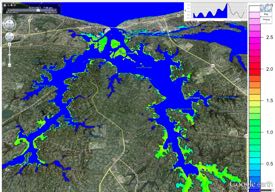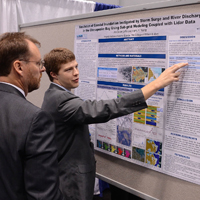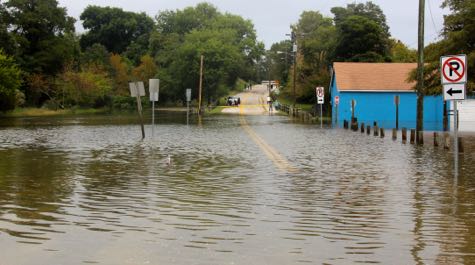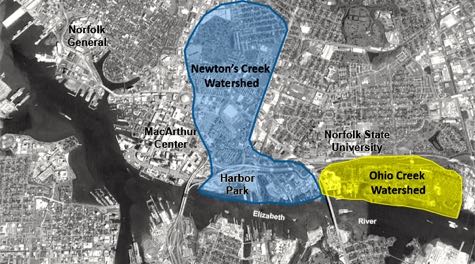VIMS report helps Virginia win $120.5M in national competition
VIMS partners in center to increase resilience to coastal flooding
Major funding from the U.S. Department of Housing and Urban Development will help William & Mary’s Virginia Institute of Marine Science continue its leadership role in the Commonwealth’s comprehensive effort to better understand the threats posed by coastal flooding and increase the resiliency of Virginia’s coastal communities.
Virginia received $120.5 million in federal funding — announced on Jan. 21 in Norfolk by HUD Secretary Julian Castro and Virginia Governor Terry McAuliffe — in response to the Commonwealth’s successful application to the National Disaster Resilience Competition. Overall, HUD awarded nearly $1 billion to eight states and five cities affected by natural disasters between 2011 and 2013. Virginia’s qualifying event was Hurricane Irene, which killed five people, left 1.1 million without power, and cost at least $182 million when it impacted the Commonwealth in August 2011. In total, Irene claimed 47 lives and cost the U.S. more than $15 billion in property damage as it moved up the East Coast.
 "Climate change is real and we must think more seriously about how to plan for it," said Castro during the announcement. "The grants we award today, and the other sources of capital these grants will leverage, will make communities stronger, more resilient, and better prepared for future natural disasters."
"Climate change is real and we must think more seriously about how to plan for it," said Castro during the announcement. "The grants we award today, and the other sources of capital these grants will leverage, will make communities stronger, more resilient, and better prepared for future natural disasters."
Virginia’s application package — titled “THRIVE” for “Resiliency in Virginia” — was a truly collaborative effort involving state, federal and local agencies; colleges and universities; community groups; residents; and businesses. Drawing on VIMS’ 2013 report to the General Assembly on recurrent coastal flooding, the application stressed the area’s vulnerability to rising seas and more intense storms while offering concrete proposals for “building water-management solutions, strengthening vulnerable neighborhoods, and improving economic vitality.”
Virginia’s HUD award goes to two projects: a $112-million plan to increase resiliency in Norfolk’s Ohio Creek watershed through construction of flood walls, living shorelines, raised roads, and other infrastructure improvements, and the remainder to a “Coastal Resilience Laboratory and Accelerator Center” that will serve as a hub for technological and organizational innovation. VIMS will participate most directly in the center.
VIMS Dean and Director John Wells says “The Accelerator Center will transform the challenge of sea-level rise into an opportunity for Virginia, bringing our best minds together to develop real-life solutions that benefit Hampton Roads and can be shared with the rest of the world.” Wells served as a member of Governor McAuliffe’s Climate Change and Resiliency Update Commission, a bipartisan group of 41 leaders from around the state whose recommendations also helped inform Virginia’s HUD application.
Mark Luckenbach, VIMS’ Associate Dean of Research and Advisory Services, says “We look forward to working with our academic partners at ODU and Norfolk State, as well as the many government agencies, community organizations, and businesses involved in efforts to make our coastline more resilient. Coastal flooding and sea-level rise affect everyone, and it’s going to take everyone to increase our resiliency and make these threats into opportunities.”
In remarks during last week’s announcement, Governor McAuliffe said the HUD funds “will significantly aid our work to protect the economic vitality and quality of life in areas like Hampton Roads by preparing now for the real impacts of climate change and sea-level rise. I look forward to working with our federal, state, and local partners to prepare every community to meet these historic challenges.”
McAuliffe also thanked fellow Virginia leaders, including Senators Tim Kaine and Mark Warner, for their support. In November, Kaine and Warner joined with congressmen Bobby Scott and Scott Rigell to send a bipartisan letter to HUD in support of Virginia’s application for grant funding.
 “This federal funding is great news for Hampton Roads and a testament to the hard work of the region’s municipalities, academic institutions like ODU and VIMS, Naval Station Norfolk, and leaders across the Commonwealth,” says Kaine.
“This federal funding is great news for Hampton Roads and a testament to the hard work of the region’s municipalities, academic institutions like ODU and VIMS, Naval Station Norfolk, and leaders across the Commonwealth,” says Kaine.
Says Warner, “By helping communities incorporate innovative policies to address the many challenges presented by extreme weather, we can create long-lasting resilience to protect Hampton Roads against the very real threat of climate change.”
The Coastal Resilience Center will operate as an independent non-profit staffed by a small team that will work with external companies to create — and quickly bring to market — innovative solutions to the challenges that rising seas bring to Virginia’s citizens, communities, marinas, ports, shipyards, Naval installations and other water-based businesses. The center will be managed by a Board of Directors that includes community, business and university leaders.
Wells says that VIMS faculty will contribute to the center’s goals by “collaboratively pursuing applied research in areas of coastal resilience where they can make unique contributions.” Likely areas of research and expertise include modeling of storm-surge and sea-level rise, improved monitoring and communication of shoreline and watershed conditions, refinement and implementation of living shorelines and other shore-protection measures and wetland migration.
The center will also have an important educational component, with particular emphasis on low- and middle-income students. Linda Schaffner, VIMS' associate dean of academic studies, says, “The Accelerator Center will provide our graduate students with another opportunity to engage in research that has direct benefits to society. Sea-level rise will threaten the world’s coastlines for decades to come, and we welcome the opportunity to give our students the knowledge and training they’ll need to deal with that challenge most effectively.”
Center staff will use a number of independent measures to gauge their success and identify areas for improvement. Measures of success will include a decrease in property-damage values and flood-insurance claims for properties in the Ohio Creek watershed during future flood events, an increase in the area of wetland and/or shoreline restoration projects, and market-proven innovations in the management of storm water.

















